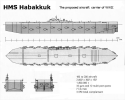'Scrapping' with the PRC is an understatement. Sure they can turtle up and make life difficult, but that has at least as much to do with geography as it does military capabilities.
To even go into 'round 2' on equal footing the PRC would have to deliver a series of victories on par with the Japanese attack on Pearl Harbor. The capability gap might be closing, but it's still there and still quite large. The sky isn't falling.
I think you may be letting your community's relative comfort in the underwater domain color your perception of the Joint domain.
Folks in the PACOM world whose business this is are nowhere near as enthusiastic. We're not going to be able to talk about the details here, but if you're confident that they've got it wrong, well, hopefully you've got more to shape that opinion than gut feeling.
It's not so much a "sky is falling" as, the trend lines don't favor continuing our continued superiority. And there are aspects where the capability gap isn't just closing, but past and opening.
Again, the sky isn't falling. There are fortunately plenty of areas of quality where they continue to lag behind.
I'll agree that over the next few decades we'd be better off focusing on how we should ramp up production vice sustaining a fleet that is 3x the size of PRC's because the American public probably won't agree to pay for the latter.
Sure. Not arguing for any particular solution vs another.
The problem statement, though, is simply that when looking at "capability" we also need to look at reconstitution, particularly if we make the assumption that any conflict with China doesn't have an objective of burning down Chinese industry to destroy their supporting infrastructure (which is...unlikely).
To simplify things, you can kill 4 DDGs for every DDG we lose...but if the enemy is also pumping out 8 DDGs for every 1 you make, in the long run, what looks like a favorable 4:1 kill ratio actually turns into a losing one.
The point was to ensure we're making an 'apples to apples' comparison. The study isn't recommending an increase of 60-70% to the current force structure, but instead 10%, because it covered everything including reserve ships. And I'm willing to bet that they were smart enough to consider our potential to ramp up ship building in that analysis.
Sure. What I'm saying is the 490 includes a considerable number of ships I would not consider likely to contribute meaningfully to any conflict.
Roughly half the Reserve Fleet ships making up that number aren't even nominally considered ready, and I don't consider the not insignificant number of tugs and berthing/barracks barges to be worth counting other than to pad the numbers.
Not really. Cost effective has two components - how much the item cost, and how well it does the task it's designed to do. I just don't see a lot of utility in USVs / UUVs in a potential high end conflict.
Your original post was this:
The Virginia class sub has ASW, ASUW, strike, SOF, and ISR in its mission sets and that program is doing just fine. So there's proof of concept that it's possible to design a ship to do more than one mission and come in under budget.
My point was over/under budget programmatically, isn't the arbiter of whether a particular solution type is viable or not.
Virginia could have come in the same amount over budget instead...it still would have been a valid solution to the problem, because a different/better one simply doesn't exist. If it had come in over budget due to crappy shipyard management, that doesn't mean a larger number of specialized subs would have panned out any better. I'm sure some budget sheet out there has F-22 over budget. Doesn't mean it was ever a flawed concept.

www.scientificamerican.com


